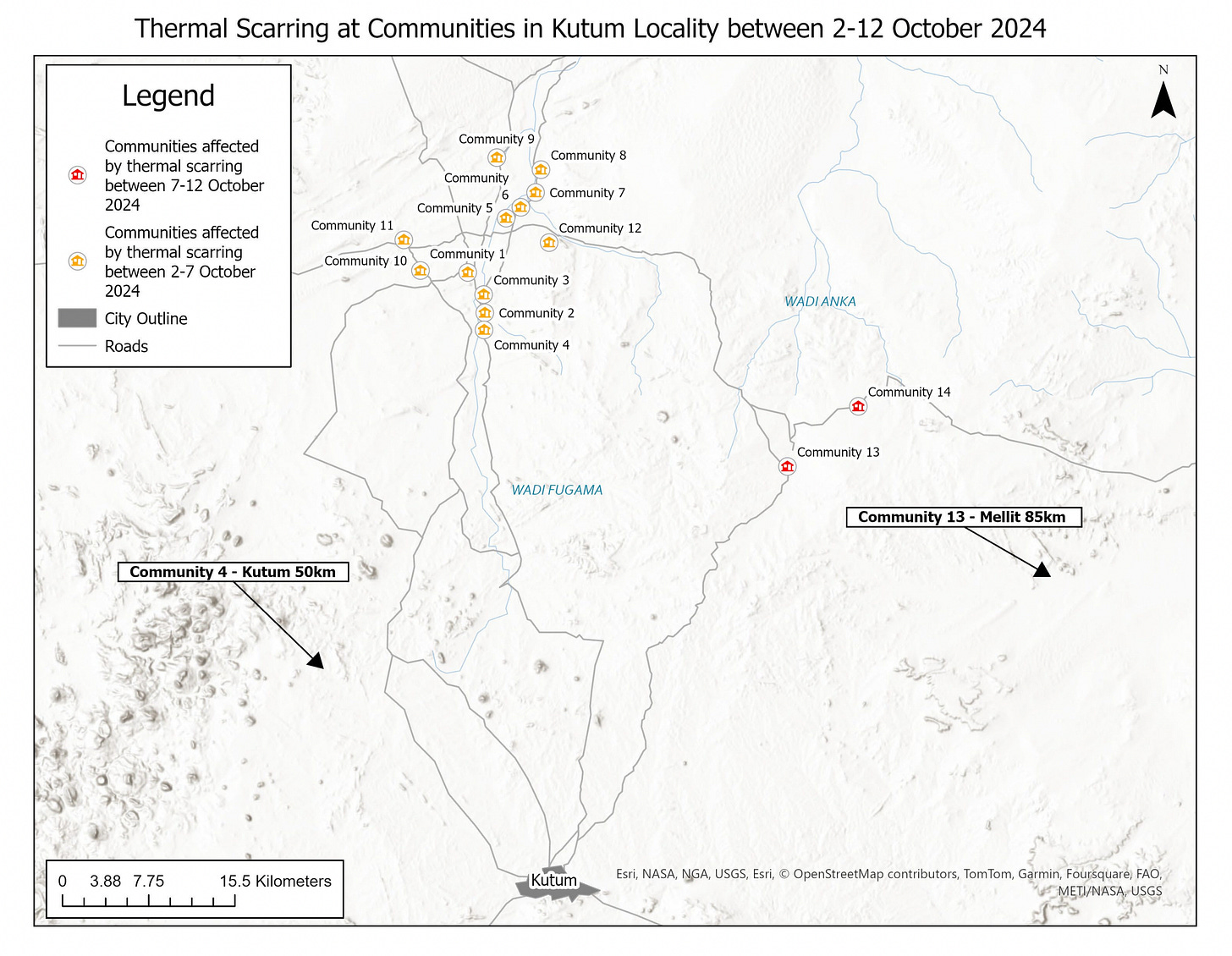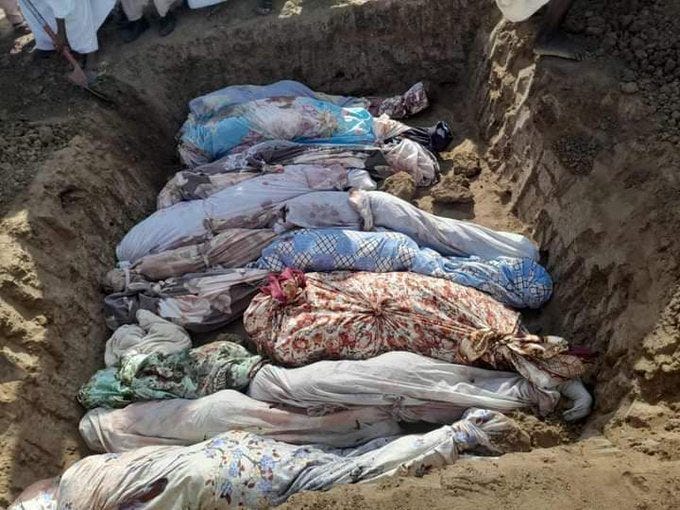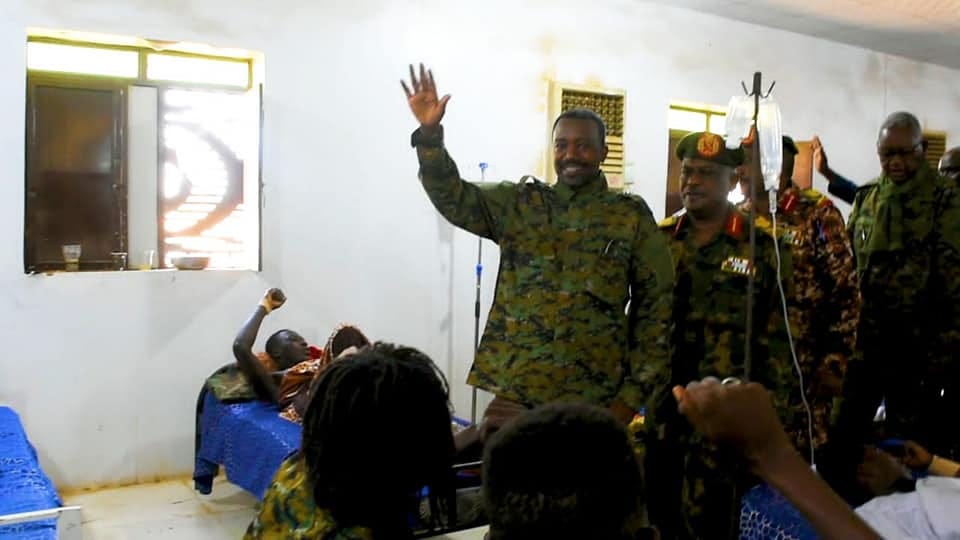Zaghawa villages burned in ethnic attacks in Darfur
Satellite evidence of RSF attacks in Kutum Locality
The Rapid Support Forces (RSF) burned 17 villages in Dar Zaghawa of North Darfur State, according to satellite imagery analyzed by the Humanitarian Research Lab at the Yale School of Public Health, a group of researchers tracking the conflict.
In a new report, the researchers made the following key findings:
At least 14 rural communities in Kutum Locality suffered likely intentional conflict-related arson attacks between 2 and 12 October 2024.
These communities are predominantly Zaghawa.
These events are consistent with an established pattern of systematic ethnic targeting of Zaghawa communities by the RSF and aligned forces.
Previously, the RSF burned Zaghawa communities in and around El Fasher, as well as Masalit communities in West Darfur. These latest attacks increase the number of arson attacks on villages in Darfur to 84 since the start of the war.
Many of the communities with visible thermal scarring are in the Bir Mezza and Disa areas, consistent with local media reports. However, not all of the specific names of the razed villages have been identified.
In line with these findings, the Coordination of Displaced Persons in North Darfur issued a statement accusing the Rapid Support Forces of conducting a scorched-earth operation targeting villages of the Zaghawa tribe, killing at least 40 innocent civilians, burning 16 villages to the ground, and forcing thousands to flee their homes into open spaces, where they are living under trees without proper shelter.
The attacks on these villages followed operations in the area by the Joint Force of Armed Struggle Movements (JSAMF), a predominantly Zaghawa group allied with the Sudanese army. A large convoy of the JSAMF recently arrived in North Darfur from Northern State via the Daba Road. Supported by local Zaghawa militias, they battled the RSF in Kutum Locality and other parts of the state and destroyed an RSF outpost at Bir Mezza, declaring the area to have been liberated.
The RSF regrouped and struck back, including by burning villages in the area. This follows the same pattern as the 2003-2005 genocide in Darfur, though in this war the Zaghawa are better armed and the conflict is thus less one-sided. We cannot rule out that some of the burned settlements were Arab settlements.
Overall, however, researchers are most concerned about a repeat of the Arab on non-Arab violence seen in the previous Darfur war. In their report, the Yale team noted,
“The RSF’s alleged attacks on these communities may represent both a continuing pattern of systematic ethnic targeting, as well as an effort to prevent support to Joint Forces.”
“Both the alleged arson attacks and clashes between RSF and Joint Forces have caused significant displacement, according to the International Organization for Migration (IOM). The IOM’s preliminary reports find that approximately 1,000 households from Bir Mezza, Disa, and surrounding villages in Kutum locality were displaced between 2-3 October 2024, and an additional 3,443 households were displaced from various villages in Kutum locality between 3-9 October 2024.”
According to the Yale Humanitarian Research Lab, the thermal pattern in all 14 targeted communities shows selective destruction of structures with unburned areas between the houses. “These phenomena, known as ‘selection,’ are forensically consistent with armed actors moving structure-to-structure, burning each structure individually… Yale HRL has previously documented instances where partially burned villages have been attacked multiple times in other areas of Darfur. Yale HRL expects that RSF, if able, may return to complete the razing of remaining structures.”
Below: A video of Joint Force soldiers, and non-uniformed gunmen mounted on camels (likely Zaghawa militia) posted to Facebook on October 2 with the caption: “This is the work of the comrades in Bir Mezza, led by General Mounir “Operations.”
Below: Fire at a village (reportedly Bir Maza area, North Darfur), with sound of small arms fire, recorded from inside an RSF combat vehicle, October 2, 2024:
Airstrike in Sennar
An airstrike by the Sudan Armed Forces struck the village of Kambrab in the Dinder area in Sennar State on Wednesday. A photograph of a mass grave for the victims showed 13-15 bodies, including several apparent children.
In videos recorded in the aftermath, angry villagers said that the victims were women and children who had nothing to do with the RSF. There were no RSF soldiers seen in circulating videos from the village, either among the dead or the living.
The tempo of Sudan Air Forces airstrikes lately seems to have increased, as well as the number of civilian casualties. This follows reports that SAF recently received new warplanes. This publication reports on some but not mass casualty events.
Thanks for reading Sudan War Monitor. We provide independent analysis of open source data, conflict events, and political developments, including peace talks and regional political dynamics affecting the conflict. Sign up for free to receive our email newsletter. Optionally, consider becoming a paying subscriber to support our work.
News in Brief
Residents of Tuti Island in Khartoum are facing tough conditions as fighting has escalated in nearby Mogran. The island, which is under control of the RSF, suffers shortages of food and medicine. One local, M.A., told Radio Tamazuj that claims of mass evacuations are false; while some families have managed to leave, most remain stranded. He said the RSF are extorting families trying to leave, with costs reaching up to 90,00 pounds. There are alarming accounts of disappearances, with families allegedly coerced into paying ransoms for their loved ones.
Radio Dabanga reports that citizens of Kosti in White Nile are still facing high prices of food, except onions, despite claims by the Sudanese army to have reopened the Sennar-Kosti road following the recent seizure of the Jebel Moya strongpoint along that road.
Chadian President Mahamat Déby yesterday issued decrees making additional changes to the leadership of various security services, including the Nomadic Guard, Gendarmerie, and the Police, following the elevation of a new security minister whose appointment was cheered by Chadian Arab RSF supporters.
Doctors Without Borders says the RSF seized a truck that it had chartered in White Nile State on September 20. The organization lost contact with the driver two weeks later and says it is concerned for his safety and the fate of the essential medical supplies that the truck was carrying.
The Gathering of Sudan Liberation Forces (GSLF) has a new training center for recruits in River Nile State, according to a press release October 6, which touted a visit by the group’s leader Abdallah Yahia to the center, as well as the Joint Force office in Ad-Damer and the 3rd Infantry Division. Earlier this year, GSLF split into a neutral faction led by Altahir Hajar and a pro-army faction led by Abdallah Yahia, who won an appointment to the sovereignty council.
During his visit to River Nile State, the GSFL commander Abdallah Yahia also visited wounded troops at the Atbara military hospital, which suggests that his forces may have been among those who participated in the recent fighting near Hajar al-Asal. Following this visit, he returned to Port Sudan.




